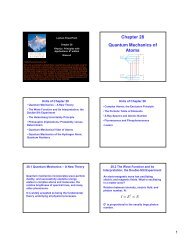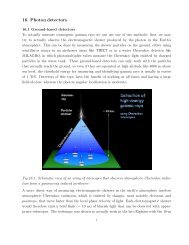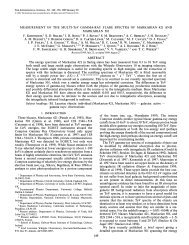Gamma-Rays Produced in Cosmic-Ray Interactions and TeV-band ...
Gamma-Rays Produced in Cosmic-Ray Interactions and TeV-band ...
Gamma-Rays Produced in Cosmic-Ray Interactions and TeV-band ...
Create successful ePaper yourself
Turn your PDF publications into a flip-book with our unique Google optimized e-Paper software.
Abstract<br />
In this work we study the <strong>in</strong>dividual contribution to diffuse γ-ray emission from the secondary<br />
products <strong>in</strong> hadronic <strong>in</strong>teractions generated by cosmic rays (CRs), <strong>in</strong> addition to the contribution<br />
of π 0 decay via the decay mode π 0 → 2γ. For that purpose we employ the Monte Carlo particle<br />
collision code DPMJET3.04 to determ<strong>in</strong>e the multiplicity spectra of various secondary particles<br />
with γ’s as the f<strong>in</strong>al decay state, that result from <strong>in</strong>elastic collisions between cosmic-ray protons<br />
<strong>and</strong> Helium nuclei <strong>and</strong> the <strong>in</strong>terstellar medium with st<strong>and</strong>ard composition.<br />
By comb<strong>in</strong><strong>in</strong>g the<br />
simulation results with a parametric model of γ-ray production by cosmic rays with energies below<br />
a few GeV, where DPMJET appears unreliable, we thus derive an easy-to-use γ-ray production<br />
matrix for cosmic ray up to about 10 PeV, that can be used to <strong>in</strong>terpret the γ-ray spectra of diffuse<br />
galactic emission <strong>and</strong> supernova remnants (SNR).<br />
We apply the γ-ray production matrix to the GeV excess <strong>in</strong> diffuse galactic γ-rays that was seen<br />
with EGRET. Although the non-π 0 contributions to the total emission have a different spectrum<br />
than the π 0 -decay component, they are <strong>in</strong>sufficient to expla<strong>in</strong> the GeV excess.<br />
We also test the hypothesis that the <strong>TeV</strong>-b<strong>and</strong> γ-ray emission of the shell-type SNR RX J1713-<br />
3946, that was observed with HESS, is caused by shock-accelerated hadronic cosmic rays. This<br />
scenario implies a very high efficacy of particle acceleration, so the particle spectrum is expected<br />
to cont<strong>in</strong>uously harden toward high energies on account of cosmic-ray modification of the shock.<br />
Us<strong>in</strong>g the χ 2 statistic we f<strong>in</strong>d that a cont<strong>in</strong>uously soften<strong>in</strong>g spectrum is strongly preferred, <strong>in</strong><br />
contrast to expectations. A harden<strong>in</strong>g spectrum has about 1% probability to expla<strong>in</strong> the HESS<br />
data, but then only if a hard cut-off at 50-100 <strong>TeV</strong> is imposed on the particle spectrum.<br />
PACS numbers: 96.50.S-, 96.60.tk, 98.70.Sa, 98.58.Mj<br />
Keywords: cosmic rays, γ-rays, hadronic <strong>in</strong>teractions, supernova remnants<br />
2







